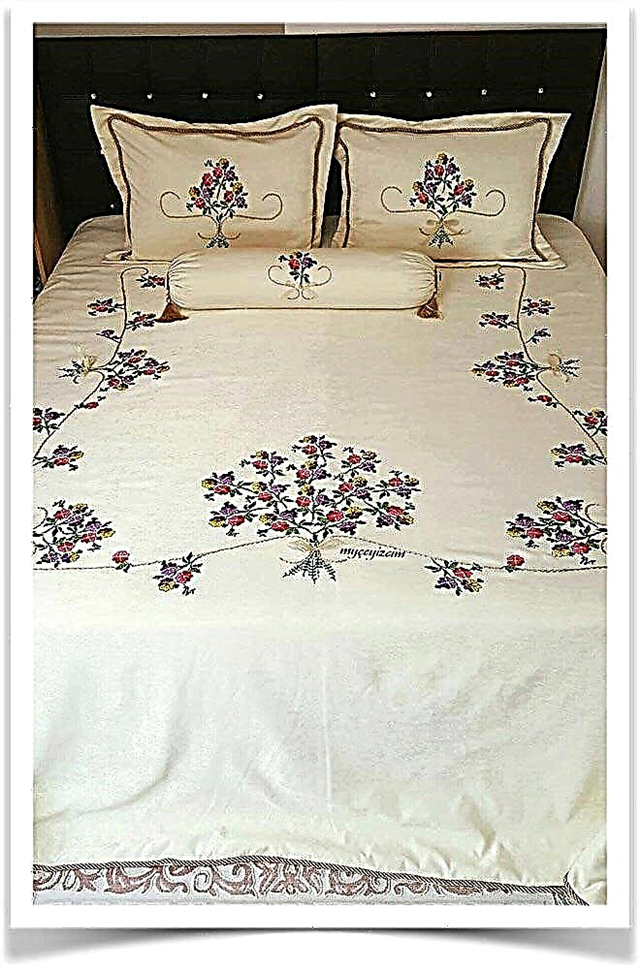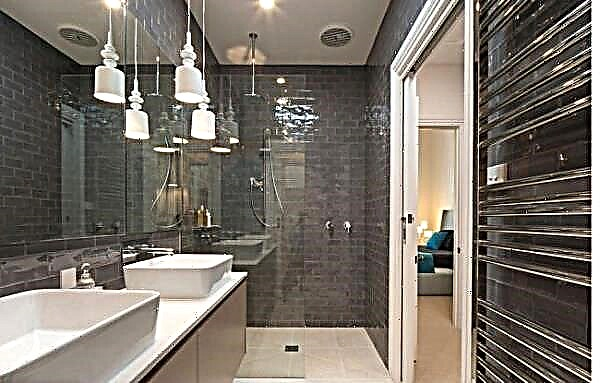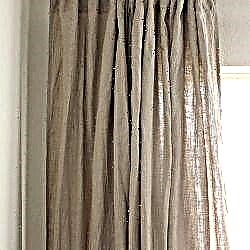Porcelain tile is a decorative material that allows you to create aesthetically completed designs and has high performance properties. This facing is among the leaders in materials, despite the fact that it appeared relatively recently.
The invention of porcelain tile was aimed at creating a cheap alternative to natural stone. Today, production has taken a step further. There are a variety of surface options that mimic wood, stone, etc. To choose porcelain tiles for the porch on the street, you need to find out what it happens.
- Technical. Of all the options, it is the most durable, but its appearance is very simple and unsightly. Most often, this finish is chosen for production sites, factories and industrial zones,
- Matt Great for outdoor stairs. Not afraid of temperature fluctuations. Wear resistance is one of the highest, but requires increased care, since it has a tendency to stain,
- Polished. Glossy (mirror) gloss - a feature of this type. Not suitable for flooring, more often used as wall decoration on the outside. The lack of polishing makes it matte,
- Glazed. Like polished, it has a shine, which is achieved through a special coating with glaze. Models have different colors and patterns. The main application is the coating of vertical surfaces. It’s not suitable for floors and steps, because it does not tolerate high loads,
- Satin It has a coating of mineral salt, due to which the surface is velvety to the touch. It has a purely decorative purpose,
- Structured. The surface imitates different surfaces: wood, stone, tile.

Pros and Cons of Porcelain Stoneware
Against the background of conventional coatings, porcelain stoneware is characterized by increased strength and wear resistance, which undoubtedly tips the balance in his favor when choosing from other coatings. He is not afraid of shock and other mechanical influences. The likelihood of cracking, chipping is minimized.
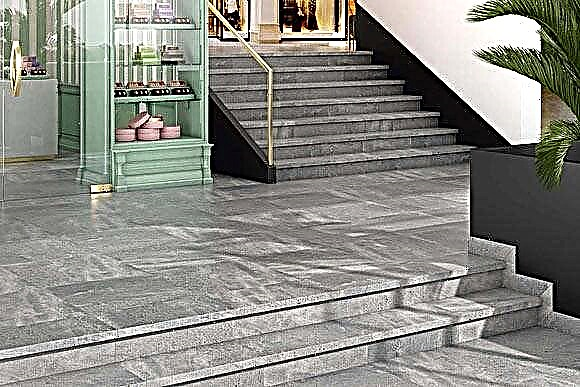 In addition, porcelain tile:
In addition, porcelain tile:
- It has proven itself when used in frosty conditions. At temperatures up to -50 ° C, the cladding behaves well,
- Moisture resistant. It does not absorb moisture.
Wear resistance differs in granite in degrees. In total there are 5. The higher the degree, the stronger the material.
The main disadvantage of facing is a large number of seams after laying on a finished staircase or site. It is they who make the finished design weak. There moisture penetrates and, freezing, it expands, which leads to the destruction of the lining. In addition, the seams violate the overall integrity of the structure.
In addition, the material is quite heavy and requires careful preparation of the base.
What is porcelain tile?
Most often, it is artificial stones that are used to decorate the room, not natural ones. The whole point is that such materials are lightweight, and this is a very important factor in construction. In addition, artificial stones can be processed much better. Therefore, accordingly, the cost is lower, but such a material is wear-resistant and durable. Thus, it turns out that porcelain stoneware is a composite, which is obtained by burning quartz, sand, clay with mineral dyes, and then further pressed under high pressure. The end result is a monolithic building material without voids and errors. During the process of manufacturing porcelain, shells or marble are mixed into the mixture. Thus, it is given the appearance of natural stone.
Pros and Cons of Material
Advantages that distinguish porcelain from other building materials:
- imitation of any surface from wood to stone,
- a diverse range of colors and textures,
- the complete absence of holes and voids inside the material,
- waterproof, can be used in different conditions: indoors and out,
- withstands different temperatures well. It has a high density, therefore it does not break down at low and high temperatures,
- resistance to chemicals,
- the surface is not erased,
- scratches can only be left with diamond,
- practically does not require special care.
But this building material has its drawbacks:
- not insulated, so the surface will always be cold,
- slippery surface
- expensive stuff.
Types and types of surfaces of porcelain tiles
- Polished - during manufacture a rough layer is removed from it, then it is ground with a diamond nozzle using water. As a result, the material sparkles and looks beautiful in products.
- Unpolished - this is a natural surface. It can be considered a defect, because after leaving the furnace it is not subjected to mechanical stress. Accordingly, low prices for this type of building material.
- Glazed - this look is special, get it by the method of matte polishing.
- Embossed (structured) - the surface looks like an old shabby stone. Such a surface does not slip, and this is a huge plus.
- Glazed is an enamelled surface. The surface as a result looks more natural, it is not sliding, but it quickly erases.
Variety of steps for stairs
Before deciding whether to build porcelain stoneware steps or not, you should know that they are of two types: solid and suture. In the store you can buy one-piece steps of a standard size or order an individually sized size for you. And their aesthetics are better than suture ones. The edges can be rounded, straight or with a relief. And suture steps consist of a set of elements - this is a corner (cornice), an attack, a riser and a plinth. In this case, there are different sizes of elements, which allows you to choose individual sizes. Mount them on a previously prepared metal, concrete or brick base.
Porcelain staircase finishing sequence
- Before starting work, we check whether there are enough procured building materials.
- We use a water-cutting machine to fit and dock structural elements. Cracks do not appear, and the material does not deteriorate.
- We cover with an acrylic primer of deep penetration. So it will be better to grasp the material with steps. Before this, it is necessary to clean them from dust and dirt.
- Porcelain tiles are laid on a special composition of glue, which should be applied with a notched trowel. We begin to work from above and gradually move down. We strictly adhere to dosages when we dilute glue.
- If a prefabricated staircase, then make sure that the joints between the parts are even, and the porcelain tile is wider than the steps or exactly corresponds to the size.
- All material that goes beyond the edges is cut off with a grinder.
- First we stack the attacks, level them, and then the approaches and cornices.
- At the very end we mount the baseboard. Remember the important point - they can be left-and right-handed.
Installation in open air is slightly different and has its own characteristics. This is due to the fact that it is necessary to further protect the material from the influence of negative weather factors. Stoneware stairs are additionally equipped with a channel to allow water to drain. Thus, moisture will not collect. And the corners are protected by a rubber profile so that frost does not form.
Porcelain Tread Care
For steps of porcelain stoneware, you do not need to select special care, it is enough to simply clean and remove them. In addition, any detergents are suitable for cleaning. The steps made of porcelain stoneware will last a long time, it can be said that their service life is endless. Functions and aesthetic appearance are maintained throughout the entire service life. Do not absorb dirt, so the original color does not change. No need to cover with special protective equipment and polish. They are revetted only once, as a result - comfortable and beautiful steps for life.
Porcelain tile is a reliable and versatile building material, which is widely used for finishing steps inside and outside the premises. It has universal properties, and for this it is used in theaters, cinemas, shopping centers and residential premises. As a result, a staircase is a chic thing that has a beautiful and expensive look.
Features
Making steps from porcelain stoneware is a small area of where this material can be applied. But it is in such elements that it looks the most profitable. Creates material from kaolin clay. Auxiliary components are added to it. It can be mica, spar, quartz.
By its characteristics, porcelain stoneware is very close to granite, and in strength it is only two points inferior to diamond. This option is more than interesting, it is worth keeping your attention on it.
Advantages and disadvantages
Porcelain tile has a set of features, due to which it is primarily considered for finishing stairwells, floors and various platforms:
High wear resistance and resistance to mechanical damage, which allows the material to be used in rooms with a high load on the floor and steps, as well as outdoors.
Water-repellent characteristics are provided due to the dense structure without pores, cracks and cavities. The manufacture of granite is associated with the use of high pressure. Porcelain steps can be installed outdoors and in rooms with high humidity.
- Inertness and lack of chemical activity expand the scope of installation of steps made of porcelain stoneware. During operation, they can be cleaned using aggressive agents, which provides easy care.
- Products perfectly tolerate temperature drops from -50 to +50 degrees.
The material does not pose any danger to the human body and does not harm the environment.
Resistance to fire and electrical conductivity.
Color fastness, despite exposure to ultraviolet radiation, intensive use, frequent cleaning and other negative factors.


The negative side also has this material. There are very few of them and they can be neutralized or minimized:
Correct and accurate installation plays a big role in ensuring long life. Material specifications may be impaired by non-compliance during installation.
A cold surface creates a lot of inconvenience when decorating a living room. This problem can be solved by using a carpet, but in this case the decorative surface of the material will be hidden. You can also install a "warm floor" system, porcelain stoneware allows you to realize this venture.
True, you will have to spend money on work and materials, but the house will be warm and beautiful.


Porcelain tile is produced in a wide variety, which expands the scope of its use and opens up unlimited possibilities for the user to implement bold design ideas.
Of the continuous sheet, products with dimensions of 120/30 cm are more often produced. The whole structure consists of tread and risers. Such steps look more neat than a similar design created by the suture method. Monolithic products are higher, but also the strength is also at a higher level. But the repair of a separate part of the steps is impossible, it is necessary to replace the entire layer.


Separate and seamless surfaces can be created from individual plates. The second option looks much better, but it requires experience and a lot of time. Although with skillful installation and a successful selection of tiles, the seams can look appropriate and harmonious. Most often, such porcelain tiles are presented in three sizes: 30/30, 45/45 and 30/60 cm.
The colors of porcelain tile are striking in variety. If desired, you can order a unique material that will make the steps the main element of the interior. Tile under the tree looks noble, fits perfectly into the classic interiors. Marble porcelain stoneware steps are a chic option that always remains relevant. Such an element of the interior will stand out favorably and will become a decoration of the room / building. White, black, green, with a low tide, a combination of several colors - any idea will find its solution in this material.




The sizes of porcelain stoneware for steps can be different, which makes the choice convenient and not difficult.
Tile with dimensions of 1200x300 mm is one of the large options that is popular among the Russian user. Porcelain tile 300x1200 can significantly reduce the number of seams. There is a tile with an even greater length - 1600x300. Such long elements will cost more than tiles with smaller dimensions, but the installation process is greatly facilitated. There are still some long steps made of porcelain stoneware, their size is 1500x300 mm. Tile 120x30 and 30x30 is easy to install, its parts are lightweight, small-sized, so you can work with it without assistance.
The processing method is one of the criteria that divides the tile into several categories. Sanded or matte tiles go through a rough grinding and minor polishing step. Steps made of such material will not slip even in frost, snow and rain. This option is primarily selected for street stairs. Unpolished steps are another good option for equipping stairs on the street. Glazed tiles are a bit mirrored, but also not slippery. It serves as a good choice for the street and premises equally. Polished tiles reflect light well, but also glides perfectly. It requires an anti-slip pad to ensure safe operation.


How to choose?
To make the right choice and buy everything you need to form complete, safe and beautiful steps, you need to know the configuration and purpose of each component:
The tread has cuts and stripes, they are necessary to ensure good adhesion to shoes and reduce slipping. Some models have grooves for collecting and discharging water, which is important for the porch.
The riser is a wall mounted vertically relative to the treads. The main characteristic is height. This element is now available in a wide variety of colors and colors. If desired, you can create a unique architectural composition.


- Skirting is a corner element. It gives the design a complete look and makes corner joints aesthetically pleasing.
The monolithic design has differences in configuration. Treads and risers are a single element.

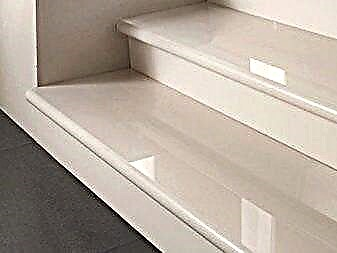
The right choice, although based on the above information, also requires compliance with the following tips and recommendations:
- Moisture absorption should be minimized. When choosing a tile, it can be moistened with water, it should spread over the surface and drain, leaving almost no trace.
- Steps on the street should be faced with rough porcelain stoneware. It will not slip even in frost and in the presence of heavy rainfall.
- When choosing a tile for outdoor work, you need to pay attention to the quality of painting. If the dye will completely fill the material, the color will retain its intensity and brightness for the entire period of operation.
- Marching stairs require the use of straight slabs. For spiral staircases, beveled elements are required.Such material is difficult to find in free sale, more often you have to make an individual order. In addition, the installation process is more complicated, but the final result is above all expectations.


In homes and apartments, you can use glazed porcelain stoneware, it looks gorgeous, but costs less than other analogues. For rooms with a high floor load, you need to choose polished, matte or unglazed material. The wear resistance and durability of these varieties of porcelain stoneware is higher.
A separate leading edge profile facilitates and reduces the cost of possible repair steps. In this case, you will need to replace only one element, and not the entire tread.
The riser height is an important parameter for choosing porcelain stoneware, which will largely determine the future work. If the height does not match the design parameters, then the risers will have to be cut. In this case, it is impractical to choose elements with a pattern; it is best to dwell on a monophonic version.
Kapinos steps have rounded edges. Such a staircase is aesthetically attractive, looks completed and more harmoniously fits into any interior.
Which porcelain tile is best for the street?
 If you choose the right material, then it will serve for a long time and at the same time it will look nice.
If you choose the right material, then it will serve for a long time and at the same time it will look nice.
When buying porcelain tiles for stairs on the street, it is worth considering:
- The manufacturer. Among the mass of manufacturers, products from Italian factories stand out. However, the price of such products will be bitten,
- Surface. It must be anti-slip, otherwise you can slip, seriously injure yourself,
- Weight. Quality material will be quite heavy. It is believed that 1 sq.m. should weigh about 19-20 kg. Lighter products are made in violation of technology,
- Sizes. They should be optimal for laying in a specific place. For stairs, this figure is 30 by 30 cm.
Porcelain stoneware facing the people is considered the right decision. If you compare it with the usual materials, then it is. However, Innoforma LLC developed and launched the production of innovative facing material, which is an order of magnitude superior to porcelain stoneware tiles for the porch on the street. This material is monolithic overlays for steps and facing slabs C3.
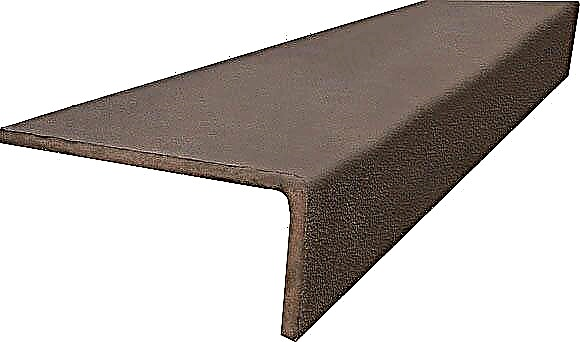 Stairs C3 are lightweight and can be mounted on any, even the old foundation. The finished design is almost seamless, which means that it is not afraid of the destructive force of moisture and temperature fluctuations. The price of linings is affordable and affordable to the masses. You can do the work yourself, which makes it possible to save additional money. The palette of stairs C3 consists of three colors: gray, brown, red, among the anti-slip relief patterns there are imitating natural stones, wavy, crystallized structures and others.
Stairs C3 are lightweight and can be mounted on any, even the old foundation. The finished design is almost seamless, which means that it is not afraid of the destructive force of moisture and temperature fluctuations. The price of linings is affordable and affordable to the masses. You can do the work yourself, which makes it possible to save additional money. The palette of stairs C3 consists of three colors: gray, brown, red, among the anti-slip relief patterns there are imitating natural stones, wavy, crystallized structures and others.
Porcelain steps - benefits
Porcelain steps have serious advantages over steps made of other materials, including natural ones. They are practically not subject to wear, as they have a uniform pattern throughout the entire depth of the material. Porcelain steps are not afraid of the fall of solid heavy objects.
The surface of such steps can be made in accordance with the requirements of future operating conditions - with a matte or glossy surface of various textures. The surface of porcelain stoneware does not absorb moisture and is not afraid of “chemistry”, so products made of this material are extremely easy to clean.

Porcelain steps are almost an “eternal” element of your home. Given that the house is being built for several generations, this is certainly an advantage. Manufacturers, as a rule, give a 50 year guarantee for products from porcelain.
Current technologies allow to produce material for the manufacture of steps in the widest color range with an imitation of almost any material. This allows you to choose exactly such steps that are ideally suited to any interior and to the general style of the house.
Which porcelain stoneware for steps to choose
When choosing porcelain stoneware for the steps of the stairs, safety is an important condition, since it is unacceptable that the surface of the material would be excessively slippery. The second criterion for choosing a material is its color. To deal with these issues, you should study the types of porcelain stoneware in more detail:
Polished- this material is obtained by grinding a natural stone with water and diamond abrasives. Its surface as a result is perfectly shiny, but unfortunately it is very slippery, which is traumatic when finishing steps.

Unpolished- after firing, this type of porcelain tile does not go through the grinding processing stage, therefore its surface has a slight roughness. It is an excellent option for decorating stairs.
Embossed Porcelain Tile, as well as its previous look, is perfect for finishing stair steps. In addition, this material has a natural stone structure and anti-slip surface.
Porcelain tile in construction and repair

About creating porcelain tile
Material created in the XX century. In its composition, the slip is a homogeneous mixture of clay and kaolin, quartz sand, feldspars and pegmatites, water. A press powder is made from these components. It is pressed with pressure from 400 to 500 kg / cm2. After firing at 12000 C. Initially, tiles were produced from it, which could withstand very large loads. Now there are new colored types of granite. The color appears due to the introduction of various oxides. They disperse during firing and stain the semi-molten mixture. It is due to this that the color of different parties may slightly differ. For example, zirconium salts are added to give a bright green color. If you want to get a blue tint, then cobalt compounds are introduced into the mixture. At the same time, colored porcelain tiles are more expensive than usual. This is due to the high cost of coloring pigments. Cost reduction can be achieved by partial staining - the top layer. At the same time, it is not possible to determine by eye whether full-stained or only porcelain is used.
Despite the continuous improvement of production, porcelain stoneware is only a skillful imitation of natural stone. This is a virtue or a disadvantage - everyone decides for himself. Unlike natural rocks, the finish has no radiation background, and natural stone, at least a little, but phonite. There are design options for decoration interspersed with pebbles, shells. It looks pretty attractive.

Features of the finishing material
Many confuse porcelain tiles and ceramic tiles. The technological principle and composition in the manufacture of a single, the only difference is that in the manufacture of ceramic tiles used more gentle temperature and more “light” (with lower pressure) pressing. Nevertheless, everything listed below is fully suitable for porcelain stoneware and ceramic tiles. Distinctive features of these finishing materials are:
- The need for minimal care, just remove the dust.
- Wear resistance, the best indicators. Quality is maintained for many years with regular use.
- Not subject to cracking and chips.
- Not subject to pigmentation from chemical compounds. Even the solvent is not afraid of him.
- Convenient for use in industrial premises.
- Strength. With proper installation, it can withstand up to several hundred kilograms per square centimeter.

Scope of porcelain tile
Porcelain tile, due to its properties, has found wide application in construction. As a rule, it is used as a facing material. And it can be found almost everywhere. There are several main areas of application of this material:
- It is used when facing rooms where there are usually a lot of people: business centers, airports, train stations, shopping centers, hotels, etc.
- It is used when facing pools and sports complexes. It is convenient for its safety and durability.
- Ventilated facades of buildings are built from porcelain tiles. This is due to durability, strength, ease of installation.
- For home decor. Great option for the bathroom. The floor will look very aesthetically pleasing. Individuality will add color. It looks stylish, beautiful, rich. But at the same time, because of the “coldness”, you may have to consider the issue of floor heating.
The scope is determined by the properties, characteristics, design decisions.
Pros and cons of porcelain stoneware
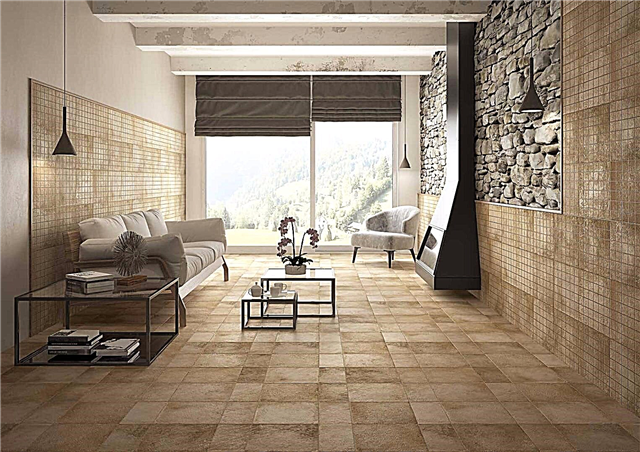
Any building material in use has both advantages and disadvantages. There is no single solution for all occasions. Rather, the pros and cons are the features of the material in each case. The advantages of porcelain stoneware can be called:
- Ability to resist pollution. Any dirt is removed quite easily, and antistatic properties contribute to less dust accumulation. Satin and polished porcelain tiles have slightly worse properties.
- Melting geometry. Porcelain tile differs very little in geometry, which greatly simplifies the process of laying and fitting. But when facing, only single-caliber tiles can be used. Otherwise, there can be no talk of aesthetics.
- Resistance to external influences. High-quality porcelain tile has a class of AA or A. It is heat-resistant, does not fade from sunlight. Chemical resistance also deserves respect.

- Low coefficient of water absorption. From here frost resistance and water resistance follow. Water resistance is achieved due to extremely low porosity. Appearance is not lost until 50 freeze-thaw cycles. In some regions, this is equivalent to 30-40 years of service.
- Abrasion resistance. Porcelain flooring will last a very long time.
- Strength. Porcelain tile is able to withstand not only static loads, but also shock. When impact is not cracked.
- Diversity. Main types: technical, polished, matte, lappated, glazed, satin, structural. You can always achieve the desired aesthetics.
But there are some disadvantages of porcelain stoneware. The material cannot be called perfect and completely universal. Cons, in principle, are few:
- Low thermal conductivity. The surface always feels cold to the touch.
- The difficulty of preparing the foundation. The surface should be perfectly flat. Failure to comply with this rule significantly reduces the life of the device.
- High price. Especially from western manufacturers.
Rules for the care of porcelain tiles
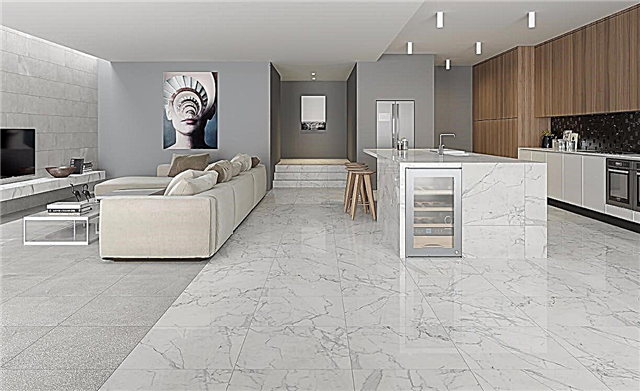
Given all the advantages of porcelain stoneware, it may give the false impression that it does not require any care. The uniqueness of this material is that it is not easily soiled and is very easy to clean.
- It must first be cleaned after installation. Glue, grout, cement do not look good. Usually use a solution of hydrochloric acid. The seams are pre-moistened with water, then cleaned with acid, but acid should not be used regularly.
- Small impurities are removed with a damp cloth. If the pollution is strong, you can use acids. Abrasive products are not recommended. They are permissible only in extreme cases. Polished porcelain tiles are especially prone to scratches.
- Dry contamination is conveniently removed with a vacuum cleaner.

- Basically, all porcelain care products contain wax. They are evenly applied to the surface, and then rubbed. After that, you can carry out wet cleaning with water. Special cleaning products allow you to mask minor defects. With regular processing, alkali-based formulations have proven themselves well. In principle, this is the most universal option.
- It is strictly forbidden to use detergents based on hydrofluoric (hydrofluoric) acid. Where the likelihood of pollution is increased, it is better to use matte porcelain stoneware.
- To remove traces of coffee, tea, cola, it is enough to rinse the contaminated area with a solution of baking soda, blood, fat is removed with alkali solutions, wax, chewing gum, the resin is washed off with solvents (acetone, gasoline), nicotine stains, rust is best washed off with dilute acid. Acid is more dangerous for surrounding materials, and not for granite.
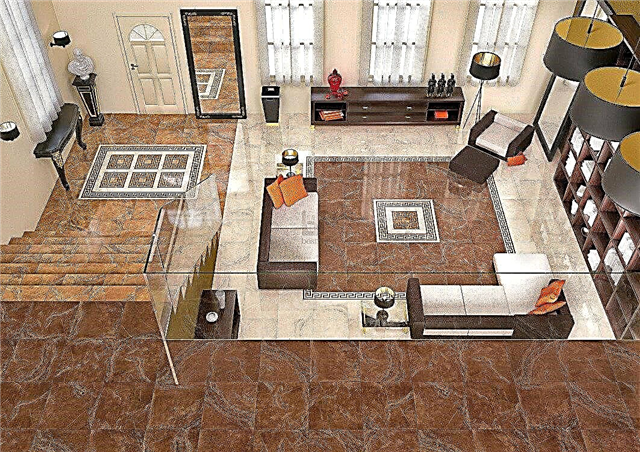
Both consumers and master builders respond positively to this material. Porcelain tile, although a relatively new material, but has already managed to prove itself very positively. He is unpretentious, but expensive. When choosing it, it is necessary to take into account the features of buildings and premises. Particular attention should be paid to the caliber of the tiles. The appearance after finishing will directly depend on it. It is advisable to take materials from one batch so that there is no difference in shade. For large areas, combinations of light and dark porcelain tiles look good. Small tiles are more suitable for unfinished surfaces. The size of the tiles should be proportional to the size of the room.
Therefore, with appropriate care, and it does not require much effort and time, this material will be optimal. Speaking of the long term, he pays for himself quite well due to the very long useful life. A long service life and a pristine look after a year will pleasantly surprise the consumer.

